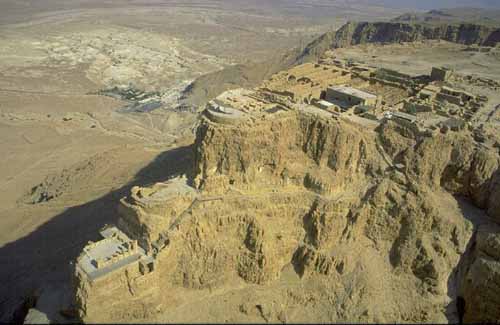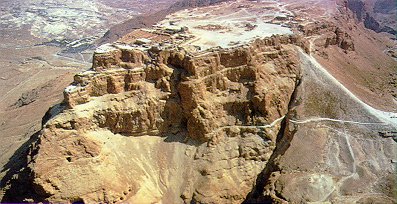Masada

Masada - one of Herod the Great's magnificent building operations in the Judean desert on top of a mountain. First made into a garrison fortress by the Hasmoneans in the 2nd Century, BCE., it eventually became a Roman fortress. When Herod began to rule in the last quarter of the 1st Century, BCE., he chose to continue its strategic use adding greatly to its comfort by introducing palaces and improving its defences and its water supplies. On Herod's death it was again taken by the Romans who dismantled Herod's kingdom.
After the fall of the Temple to Vespasian and his son Titus, in 69 CE., it fell into the hands of those legendary defenders, the Zealots, led by Eliezer ben Yair. Ben Yair fled here with about 950 fellow rebels, capturing it by some kind of subterfuge from the Roman garrison (Josephus is unclear as to how), and they remained here under siege to the Roman commander, Flavius Silva and his army of 15,000, for three years. At the end of that time the Romans, who in the meantime had built a ramp (see the second picture, below), leading up to the walls from the western approach, broke in only to find their adversaries slaughtered. Not wishing to fall under the barbaric rule of Rome, see their womenfolk and children butchered or worse, the Zealots had decided to enter into a communal suicide pact. Choosing by lot ten members in each group to slay all the others and then kill themselves, the deed was done and so was born the story of the heroism of Masada.
Both my pictures show very clearly the three gigantic "steps" on the northern face, where Herod constructed his "three-tiered" palace, the remains of which can be seen.
The second picture shows clearly the so-called "white promontory" (Josephus, Wars: Book 7; Cap VIII; v.5), on which Silva constructed the ramp the remains of which are shown here.
